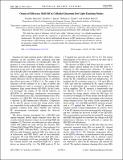Origin of Efficiency Roll-Off in Colloidal Quantum-Dot Light-Emitting Diodes
Author(s)
Shirasaki, Yasuhiro; Supran, Geoffrey J; Tisdale, William; Bulovic, Vladimir
DownloadBulovic_Origin of efficiency.pdf (1.299Mb)
PUBLISHER_POLICY
Publisher Policy
Article is made available in accordance with the publisher's policy and may be subject to US copyright law. Please refer to the publisher's site for terms of use.
Terms of use
Metadata
Show full item recordAbstract
We study the origin of efficiency roll-off (also called “efficiency droop”) in colloidal quantum-dot light-emitting diodes through the comparison of quantum-dot (QD) electroluminescence and photoluminescence. We find that an electric-field-induced decrease in QD luminescence efficiency—and not charge leakage or QD charging (Auger recombination)—is responsible for the roll-off behavior, and use the quantum confined Stark effect to accurately predict the external quantum efficiency roll-off of QD light-emitting diodes.
Date issued
2013-05Department
Massachusetts Institute of Technology. Department of Chemical Engineering; Massachusetts Institute of Technology. Department of Electrical Engineering and Computer Science; Massachusetts Institute of Technology. Department of Materials Science and Engineering; Massachusetts Institute of Technology. Research Laboratory of ElectronicsJournal
Physical Review Letters
Publisher
American Physical Society
Citation
Shirasaki, Yasuhiro; Supran, Geoffrey J.; Tisdale, William A. et al. “Origin of Efficiency Roll-Off in Colloidal Quantum-Dot Light-Emitting Diodes.” Physical Review Letters 110, 21 (May 2013): 217403 © 2013 American Physical Society
Version: Final published version
ISSN
0031-9007
1079-7114